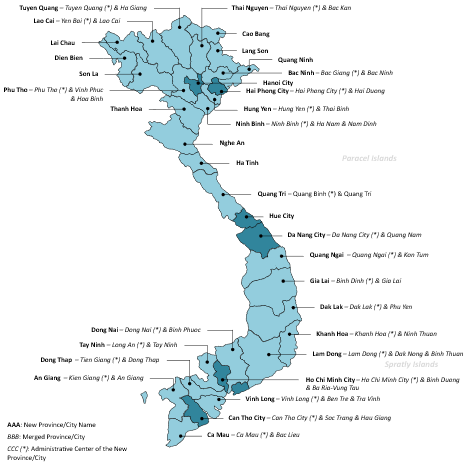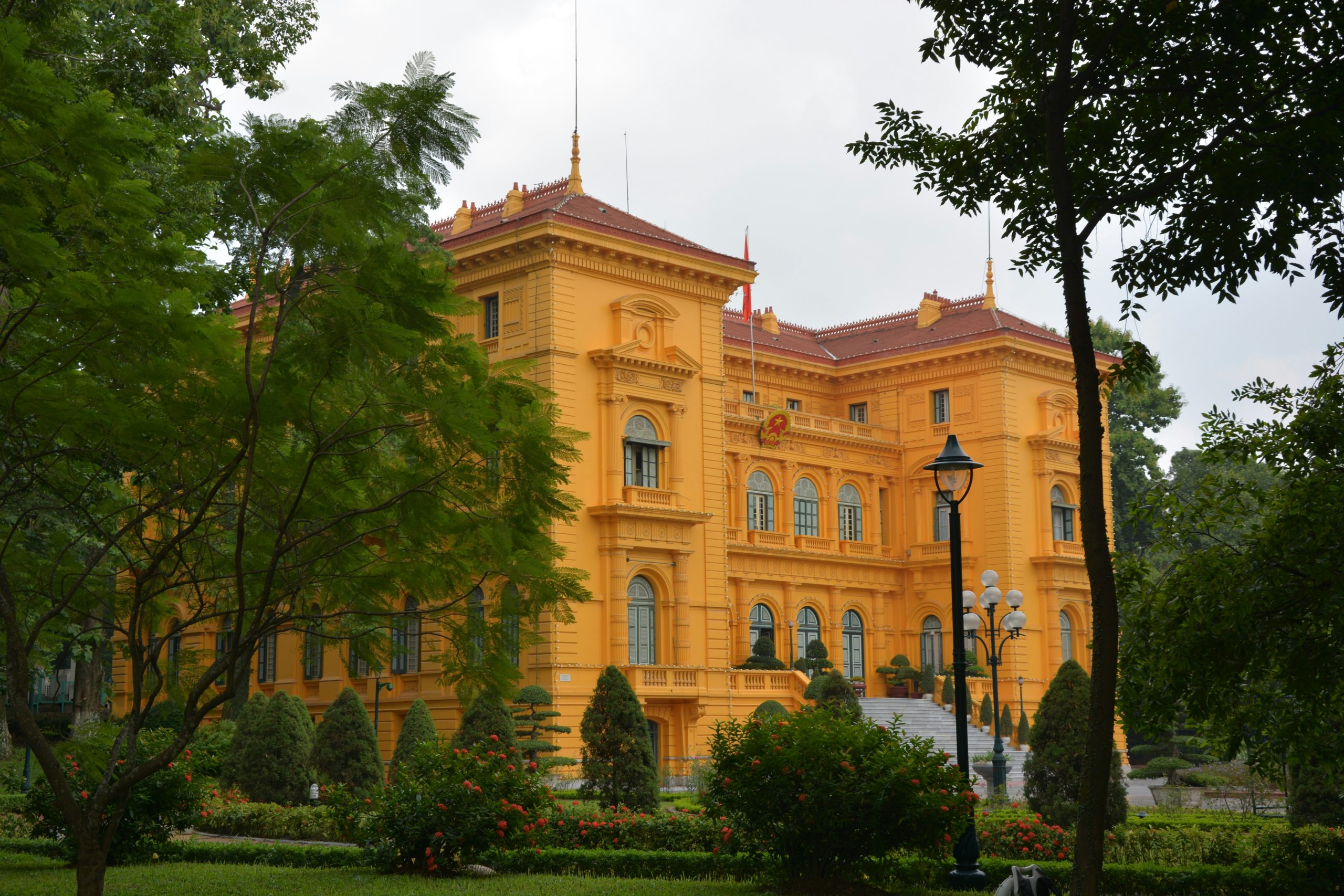
01Jul2025
Latest News & Report / Vietnam Briefing
Comments: No Comments.
On June 12th, 2025, Vietnam’s National Assembly approved a landmark resolution to reduce the number of provincial-level administrative units from 63 to 34. This sweeping reform marks the country’s most significant administrative restructuring in decades, aimed at creating a more streamlined, modern governance system ready to capture emerging opportunities in the new era.
Vietnam’s Plan for Restructuring of Provincial-Level Administrative Units
Since 2008, Vietnam has maintained a 63-unit provincial system with a three-tier administrative structure, following the expansion of Hanoi[1]. While this model ensured consistent government oversight, the rapid creation of new commune-level units led to fragmentation, inefficiencies, and difficulties in meeting national standards[2] [3]. These systemic challenges prompted policymakers to reconsider the structure of public administration, as noted in Conclusion No. 121-KL/TW issued by the Central Committee on January 24th, 2025[4].
After extensive discussions in early 2025, Vietnam’s 13th Party Central Committee approved a major reform on April 12th, introducing the proposal on the reorganization of administrative units and the development of a two-tier governance system locally under Resolution No. 60-NG/TW[5]. The plan retains 11 provincial-level units and merges the remaining 52, reducing the total to 34, including 6 centrally governed cities and 28 provinces. Decision No. 759/QD-TTg[6], signed on April 14th, provides a detailed proposal on restructuring, with key information on the merging of provinces and cities.
Vietnam’s Provinces after Restructuring
Source: B&Company Vietnam[7]
On June 12th, 2025, Vietnam’s National Assembly passed Resolution No. 202/2025/QH15[8] on the Reorganization of Provincial-Level Administrative Units. The resolution provides the official merging situation of each province, the new provinces’ names, and their socio-geographical indicators.
Table 1: Merging Situation of Provincial-level Administrative Units in 2025
| 6 Centrally Governed Cities | |||||||
| No. | Provinces/Cities | Population
(Thousand people) |
Total Area
(Km2) |
Merging Situation | Commune-level administrative units | ||
| Wards | Communes | Special Zones | |||||
| 1 | Hanoi City | 8,718 | 3,360 | Unchanged | 75 | 51 | – |
| 2 | Hue City | 1,236 | 4,947 | Unchanged | 21 | 19 | – |
| 3 | Ho Chi Minh City | 14,003 | 6,773 | Ho Chi Minh City, Binh Duong, Ba Ria– Vung Tau | 113 | 54 | 1 |
| 4 | Hai Phong City | 4,664 | 3,195 | Hai Phong City, Hai Duong | 45 | 67 | 2 |
| 5 | Da Nang City | 3,066 | 11,860 | Da Nang City, Quang Nam | 23 | 70 | 1 |
| 6 | Can Tho City | 4,200 | 6,361 | Can Tho City, Soc Trang, Hau Giang | 31 | 72 | – |
| 28 Provinces | |||||||
| No. | Provinces/Cities | Population
(Thousand people) |
Total Area
(Km2) |
Merging Situation | Commune-level administrative units | ||
| Wards | Communes | Special Zones | |||||
| 7 | Lai Chau | 496 | 9,069 | Unchanged | 02 | 36 | – |
| 8 | Dien Bien | 657 | 9,540 | Unchanged | 03 | 42 | – |
| 9 | Son La | 1,331 | 14,110 | Unchanged | 08 | 67 | – |
| 10 | Lang Son | 814 | 8,310 | Unchanged | 04 | 61 | – |
| 11 | Quang Ninh | 1,397 | 6,208 | Unchanged | 30 | 22 | 02 |
| 12 | Thanh Hoa | 3,764 | 11,115 | Unchanged | 19 | 147 | – |
| 13 | Nghe An | 3,442 | 16,487 | Unchanged | 11 | 119 | – |
| 14 | Ha Tinh | 1,330 | 5,994 | Unchanged | 60 | 09 | – |
| 15 | Cao Bang | 559 | 6,700 | Unchanged | 03 | 53 | |
| 16 | Tuyen Quang | 1,865 | 13,796 | Tuyen Quang, Ha Giang | 07 | 117 | – |
| 17 | Lao Cai | 1,779 | 13,257 | Yen Bai, Lao Cai | 10 | 89 | – |
| 18 | Thai Nguyen | 1,799 | 8,375 | Thai Nguyen, Bac Kan | 15 | 77 | – |
| 19 | Phu Tho | 4,023 | 9,361 | Phu Tho, Vinh Phuc, Hoa Binh | 15 | 133 | – |
| 20 | Bac Ninh | 3,619 | 4,719 | Bac Giang, Bac Ninh | 33 | 66 | – |
| 21 | Hung Yen | 3,568 | 2,515 | Hung Yen, Thai Binh | 11 | 93 | – |
| 22 | Ninh Binh | 4,412 | 3,943 | Ninh Binh, Ha Nam, Nam Dinh | 32 | 97 | – |
| 23 | Quang Tri | 1,871 | 12,700 | Quang Binh, Quang Tri | 08 | 69 | 01 |
| 24 | Quang Ngai | 2,162 | 14,833 | Quang Ngai, Kon Tum | 09 | 86 | 01 |
| 25 | Gia Lai | 3,584 | 21,577 | Binh Dinh, Gia Lai | 25 | 110 | – |
| 26 | Khanh Hoa | 2,244 | 8,556 | Khanh Hoa, Ninh Thuan | |||
| 27 | Lam Dong | 3,873 | 24,233 | Lam Dong, Dak Nong, Binh Thuan | 20 | 103 | 01 |
| 28 | Dak Lak | 3,347 | 18,096 | Dak Lak, Phu Yen | 14 | 88 | – |
| 29 | Dong Nai | 4,491 | 12,737 | Dong Nai, Binh Phuoc | 23 | 72 | |
| 30 | Tay Ninh | 3,254 | 8,537 | Long An, Tay Ninh | 14 | 82 | – |
| 31 | Vinh Long | 4,258 | 6,296 | Vinh Long, Ben Tre, Tra Vinh | 19 | 105 | – |
| 32 | Dong Thap | 4,370 | 5,939 | Tien Giang, Dong Thap | 20 | 82 | – |
| 33 | Ca Mau | 2,607 | 7,942 | Ca Mau, Bac Lieu | 09 | 55 | – |
| 34 | An Giang | 4,952 | 9,889 | Kien Giang, An Giang | 14 | 85 | 03 |
Source: Resolution No. 202/2025/QH15, Provincial Statistics Offices[9], Resolutions on the Reorganization of Commune-Level Administrative Units, B&Company synthesis
Implementation of the Two-tier Local Governance System
In addition to merging provincial-level units, Vietnam’s 2025 administrative reform includes the abolishment of the district-level administrative units and introduces a two-tier local governance system:
– The provincial-level administrative units, including provinces and centrally governed cities, act as the primary authority overseeing commune-level governance. They issue resolutions, decisions, and directives to guide, manage, and supervise lower-level operations within their jurisdiction.
– The commune-level administrative units, comprising communes, wards, and special zones, function as the executive tier responsible for implementing policies with a degree of autonomy. Their operations align with the legal and policy frameworks established by the central and provincial governments. Additionally, commune-level governments manage local socio-economic development and are accountable to their respective provincial authorities.
On April 9th, the government approved 34 proposals to reorganize commune-level administrative units under Resolution No. 126/NQ-CP[10]. On June 16th, National Assembly Chairman Tran Thanh Man signed and promulgated 34 resolutions of the National Assembly Standing Committee on the reorganization of commune-level administrative units in 34 provinces and centrally governed cities[11]. As a result, 9,907 units (7,570 communes, 1,720 wards, and 617 towns) will be consolidated into 3,193, effectively reducing two-thirds of Vietnam’s commune-level units.
The reform roadmap was initially outlined in Plan No. 47-KH/BCD following Decision No. 759/QD-TTg signed on April 14th and later accelerated by Resolution No. 162/NQ-CP on June 7th. Conclusion No. 167-KL/TW[12], signed on June 13th, further speeds up the process and aligns the official operation of both provincial- and commune-level bodies on July 1st, signaling the government’s commitment to streamlined governance and the necessity of administrative reformation. The reform involves the simultaneous consolidation of provincial- and commune-level administrative units and the abolishment of the district level. All agencies, organizations, and authorities will begin operating under a unified two-tier governance model nationwide from July 1st, 2025, marking a significant shift in local governance and regional planning.
Implications of Vietnam’s Administrative Reform
Vietnam’s recent governance reforms carry significant positive implications for the business environment, particularly in streamlining administrative procedures and setting clearer development directions for the future. The consolidation of provincial- and commune-level administrative units helps eliminate overlapping responsibilities and reduce bureaucratic redundancy. This restructuring fosters more transparent reporting lines and enables more responsive and efficient governance. Importantly, the merging of administrative units leads to the creation of larger and more viable economic zones, enhancing their appeal to infrastructure and industrial investment. Aligning provinces with similar economic strengths also allows for better coordination in regional development strategies, helping to amplify competitive advantages and growth potential across regions. Notably, the country will have 21 coastal provinces, helping landlocked provinces to unlock new growth opportunities in tourism, logistics, and transportation.
Conclusion
Vietnam’s efforts to restructure its provincial administrative units and pilot a two-tier local governance system mark a significant shift toward a more modern, efficient, and decentralized public administration model. These changes are expected to enhance service delivery, improve investment conditions, and better align local development with national priorities.
[1] TVPL. Resolution No. 15/2008/QH12 adjusting administrative boundaries of Hanoi city and related provinces <Access>
[2] TVPL. Resolution No. 1211/2016/UBTVQH13 on the Standards and Classification of Administrative Units <Access>
[3] TVPL. Resolution No. 27/2022/UBTVQH15 amending Resolution No. 1211/2016/UBTVQH13 on the Standards and Classification of Administrative Units <Access>
[4] TVPL. Conclusion No. 121-KL/TW on the review of Resolution No. 18-NQ/TW of the Sixth Plenum of the 12th Central Executive Committee <Access>
[5] Government Documents. Resolution No. 60-NG/TW of the 11th Conference of the 13th Party Central Committee <Access>
[6] TVPL. Decision No. 759/QD-TTg approving the Proposal on Reorganization of Administrative Units at Various Levels and the Construction of a Two-Tier Local Government Structure <Acgôicess>
[7] For official map of Vietnam, please visit the Department of Survey, Mapping, and Vietnam Geographic Environment <Access>
[8] TVPL. Resolution No. 202/2025/QH15 on the Reorganization of Provincial-Level Administrative Units <Access>
[9] Merged provinces’ indicators are provided under Resolution No. 202/2025/QH15, while unchanged provinces’ are collected from reports of Provincial Statistics Offices.
[10] TVPL. Resolution No. 126/NQ-CP on the Proposal for the Reorganization of Commune-Level Administrative Units in 2025 <Access>
[11] Government News. 34 Resolutions of the National Assembly Standing Committee on the Reorganization of Commune-Level Administrative Units <Access>
[12] TVPL. Conclusion No. 167-KL/TW of the Politburo and the Party Secretariat on the Policy for Organizational and Administrative Unit Restructuring, with Simultaneous Implementation at Provincial and Communal Levels from July 1, 2025 <Access>
* If you wish to quote any information from this article, please kindly cite the source along with the link to the original article to respect copyright.
| B&Company
The first Japanese company specializing in market research in Vietnam since 2008. We provide a wide range of services including industry reports, industry interviews, consumer surveys, business matching. Additionally, we have recently developed a database of over 900,000 companies in Vietnam, which can be used to search for partners and analyze the market. Please do not hesitate to contact us if you have any queries. info@b-company.jp + (84) 28 3910 3913 |











